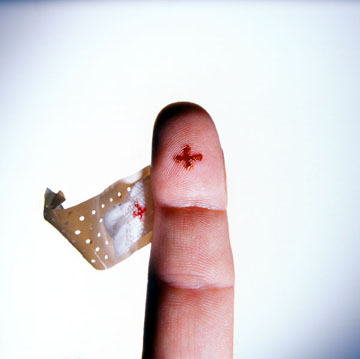 |
| FIRST AID WOUNDS AND BLEEDING SMALL CUTS: Wash with (mild) soap and remove any foreign material (bits that aren't you) to decrease the risk of infection. Applying a sterile dressing helps keep cuts clean and stops them sticking to your clothes. Use a first aid ointment if you wish, but not alcohol, hydrogen peroxide or iodine solutions cos they don't promote healing or prevent infection. For small cuts generally the only care they will need is being kept clean and dry. LARGE WOUNDS: If you think you may need stitches then seek medical care early, as delay can lead to increased risk of infection. Examine wound for embedded objects, apply direct pressure and a sterile dressing. Elevate the wound if possible. If bleeding is heavy call 999 and request medical assistance. If you are in school or college find a first aider. INFECTION Redness, warmth, swelling, increased pain or pus indicate infection- see your doc! If the skin surrounding the cut is red-streaked, this could indicate an infection of the lymph system. This is serious and prompt medical care should be sought. |
| HOW DO I KNOW WHEN TO SEEK HELP? If you feel out of control, have harmed yourself, are considering suicide or feel overwhelmed and you really don't feel that you are safe enough to wait until these feelings pass, then it is usually a good idea to seek help. Do whatever you need to do to keep yourself (and others) safe. Try to remember that It is better to be on the safe side. |
| BURNS AND SCALDS Hold injured area under cold running water for *at least* 10 minutes If you have some, chlorhexidine solution can be used to clean the area Dress the area with clean, sterile and NON-FLUFFY dressing If burns are serious seek medical help DO NOT use adhesive dressings or cotton wool DO NOT break any blisters DO NOT use ice on the wound- it can cause more damage The treatement of burns depends on their depth and location. Burn depth is split into 3 categories First degree burns are the least serious of three, characterised by redness in the skin, but sensation in still intact and they are usually painful. Second degree burns look similar, but the skin is blistered and the pain more intense Third degree burns are where the skin cells are completely dead, and the skin appears white and without sensation. First degree burns can be treated with Aloe Vera, antibiotics, or antiseptics all available over the counter. Second and third degree burns require immediate professional medical attention. Special anti-septics including silver nitrate, silver sulfdiazine and mafenide are available. POISONING If you are the casualty, call for help immediately and notify a friend or relative Place the casualty in recovery position if appropriate. Keep them still and call for help. Monitor their... Airway (by removing obvious obstructions) Breathing (tilt head gently back and listen for at least 20 seconds) Circulation (check for pulse) DO NOT induce vomiting |
| If you are unsure of whether or not you need immediate medical help, please call a HELPLINE. |
| DO NOT remove embedded objects DO NOT remove dressings once applied- if bleeding persists apply additional dressings over the original one or seek medical attention. |